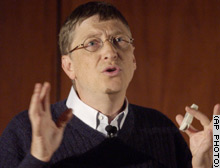
March 5, 2004
from
CNN
Website
NEW YORK (AP)
-- If the U.S. Postal Service delivered mail for
free, our mailboxes would surely runneth over with more credit-card offers,
sweepstakes entries, and supermarket fliers. That's why we get so much junk
e-mail: It's essentially free to send. So Microsoft Corp. chairman Bill
Gates, among others, is now suggesting that we start buying "stamps" for
e-mail.
Many Internet analysts worry, though, that turning e-mail into an economic
commodity would undermine its value in democratizing communication. But
let's start with the math: At perhaps a penny or less per item, e-mail
postage wouldn't significantly dent the pocketbooks of people who send only
a few messages a day.
Not so for spammers who mail millions at a time.

Microsoft's Bill Gates, among
others,
is suggesting computer users
start buying "stamps" for e-mail.
Though postage proposals have been in limited
discussion for years - a team at Microsoft Research has been at it
since 2001 - Gates gave the idea a lift in January at the World Economic
Forum in Davos, Switzerland. Details came last week as part of
Microsoft's anti-spam strategy. Instead of paying a penny, the sender would
"buy" postage by devoting maybe 10 seconds of computing time to solving a
math puzzle. The exercise would merely serve as proof of the sender's good
faith.
Time is money, and spammers would presumably have to buy many more machines
to solve enough puzzles. The open-source software Hashcash, available
since about 1997, takes a similar approach and has been incorporated into
other spam-fighting tools including Camram and Spam Assassin.
Meanwhile, Goodmail Systems Inc. has been in touch with Yahoo! Inc.
and other e-mail providers about using cash. Goodmail envisions
charging bulk mailers a penny a message to bypass spam filters and avoid
being incorrectly tossed as junk. That all sounds good for curbing spam, but
what if it kills the e-mail you want as well?
Consider how simple and inexpensive it is today to e-mail a friend,
relative, or even a city-hall bureaucrat. It's nice not to have to calculate
whether greeting grandma is worth a cent. And what of the communities now
tied together through e-mail - hundreds of cancer survivors sharing tips on
coping; dozens of parents coordinating soccer schedules?
Those pennies add up.
"It detracts from your ability to speak and
to state your opinions to large groups of people," said David Farber, a
veteran technologist who runs a mailing list with more than 20,000
subscribers. "It changes the whole complexion of the net."
Goodmail chief executive Richard
Gingras said individuals might get to send a limited number for free,
while mailing lists and nonprofit organizations might get price breaks.
But at what threshold would e-mail cease to be free? At what point might a
mailing list be big or commercial enough to pay full rates? Goodmail
has no price list yet, so Gingras couldn't say.
Vint Cerf, one of the Internet's founding
fathers, said spammers are bound to exploit any free allotments.
"The spammers will probably just keep
changing their mailbox names," Cerf said. "I continue to be impressed by
the agility of spammers."
And who gets the payments? How do you build and
pay for a system to track all this? How do you keep such a system from
becoming a target for hacking and scams?
The proposals are also largely U.S.-centric, and even with seamless currency
conversion, paying even a token amount would be burdensome for the
developing world, said John Patrick, former vice president of Internet
technology at IBM Corp.
"We have to think of not only, let's say,
the relatively well-off half billion people using e-mail today, but the
5 or 6 billion who aren't using it yet but who soon will be," Patrick
said.
Some proposals even allow recipients to set
their own rates. A college student might accept e-mail with a one-cent
stamp; a busy chief executive might demand a dollar.
"In the regular marketplace, when you have
something so fast and efficient that everyone wants it, the price goes
up," said Sonia Arrison of the Pacific Research Institute, a think tank
that favors market-based approaches.
To think the Internet can shatter class
distinctions that exist offline is "living in Fantasyland," Arrison said.
Nonetheless, it will be tough to persuade people to pay -- in cash or
computing time that delays mail -- for something they are used to getting
for free.
Critics of postage see more promise in other approaches, including
technology to better verify e-mail senders and lawsuits to drive the big
spammers out of business.
"Back in the early '90s, there were e-mail
systems that charged you 10 cents a message," said John Levine, an
anti-spam advocate. "And they are all dead."

